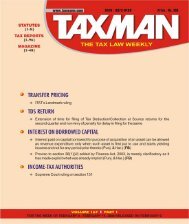news round up - Taxmann
news round up - Taxmann
news round up - Taxmann
- TAGS
- news
- round
- taxmann
- taxmann.com
You also want an ePaper? Increase the reach of your titles
YUMPU automatically turns print PDFs into web optimized ePapers that Google loves.
114 GOODS & SERVICES TAX - MAGAZINE [Vol. 1<br />
GST in other countries<br />
2. GST was, for the first time, adopted in France in the year 1954. Earlier,<br />
France was having a VAT system. Now GST is levied in nearly 140<br />
countries. In the discussion to follow, the salient aspects of the tax as<br />
prevalent in some countries are being mentioned for comparative study :<br />
2.1 AUSTRALIAN GST - Australian GST has been evolved after consideration<br />
of models of other countries. It is broadly structured on the New Zealand<br />
GST though Australia has taken benefit of the experiences and laws of<br />
other countries also. It was introduced by the Australian Federal Government<br />
in the year 1999 effective from July 1, 2000. The basic objective of<br />
this tax was to broaden the tax base for goods and services.<br />
In Australia, the GST is a broad based tax at 10 per cent on most goods and<br />
services and is included in the price paid. Registered business units are<br />
entitled for tax credit and the burden of the tax ultimately falls on the<br />
consumers for goods purchased and services availed of. Most food items<br />
like meat, fruits and vegetables are exempt from GST barring items like<br />
prepared food, take away food, restaurant meals, confectionery, icecream,<br />
snack foods, alcoholic beverages and soft drinks. Educational and<br />
health services, eligible child care, exports of goods and services, religious<br />
services, non-commercial activities of charitable institutions, cars for use<br />
of disabled people and few other goods and services are also not subjected<br />
to GST.<br />
Some other aspects of Australian GST are :—<br />
� The concept of Time of S<strong>up</strong>ply is dealt with through a series of<br />
attribution rules that dictate when a GST liability arises. The concept<br />
of Place of S<strong>up</strong>ply is achieved through a series of rules that connect<br />
various s<strong>up</strong>plies with Australia, thereby making them potentially<br />
taxable.<br />
� Another unique feature of the Australian legislation is the introduction<br />
of the concept of reduced input tax credits. Those that make<br />
financial s<strong>up</strong>plies are able to claim reduced credits for certain inputs<br />
used to make those s<strong>up</strong>plies. Primarily it is for those services purchased<br />
externally that could have been provided in-house.<br />
� In drafting the law, the Australian approach was to use language that<br />
was as descriptive as possible. For example, instead of labelling<br />
s<strong>up</strong>plies of things such as financial s<strong>up</strong>plies as exempt, they are called<br />
input taxed s<strong>up</strong>plies. It helped to understand law easily.<br />
2.2 NEW ZEALAND’S GST - New Zealand imposes GST on almost all goods<br />
and services at the rate of 12.5 per cent. Taxable goods and services<br />
include all types of real and personal properties other than money.<br />
Services cover everything other than goods like repair services, doctor’s<br />
services, accountant’s services, etc. However, these have to be part of<br />
taxable business activity. Such goods and services do not include :—<br />
GOODS & SERVICES TAX CASES ❑ JANUARY 20 - FEBRUARY 4, 2010 ◆ 24











![“FORM NO. 3CEB [See rule 10E] Report from an ... - Taxmann](https://img.yumpu.com/45480232/1/190x245/form-no-3ceb-see-rule-10e-report-from-an-taxmann.jpg?quality=85)





